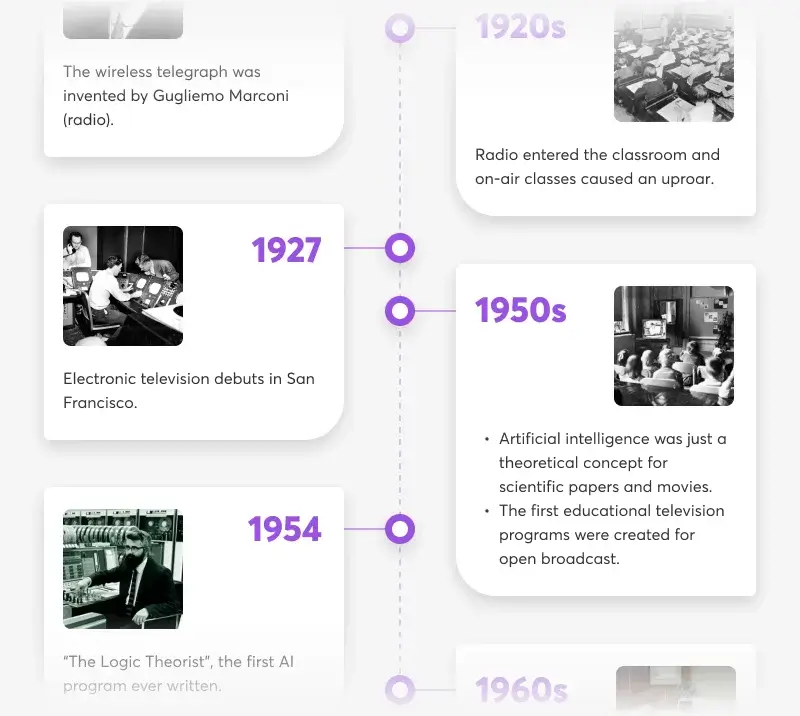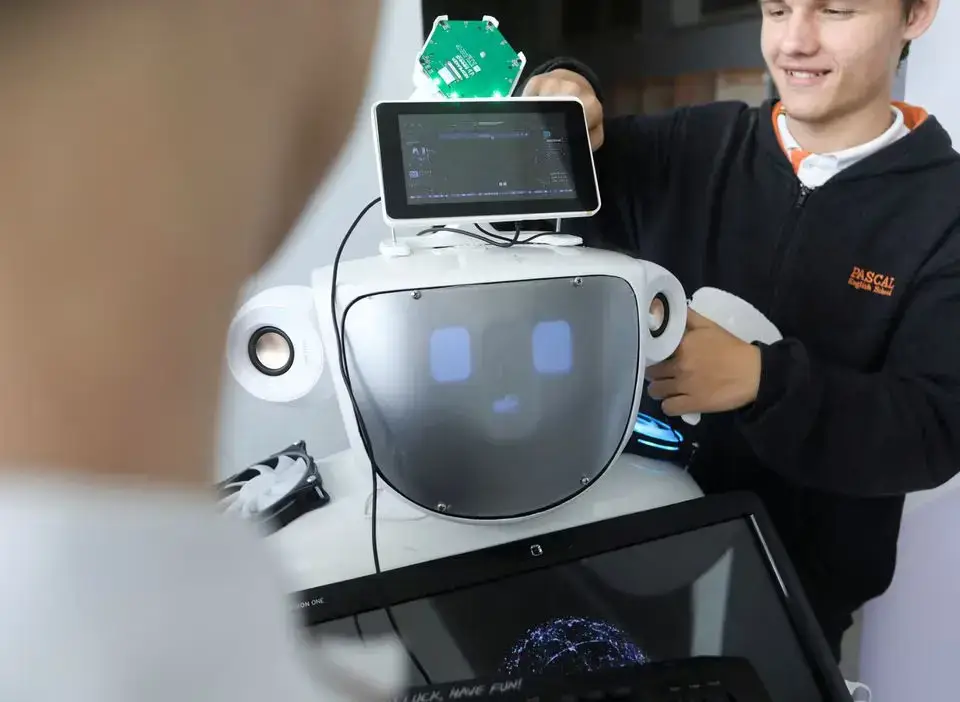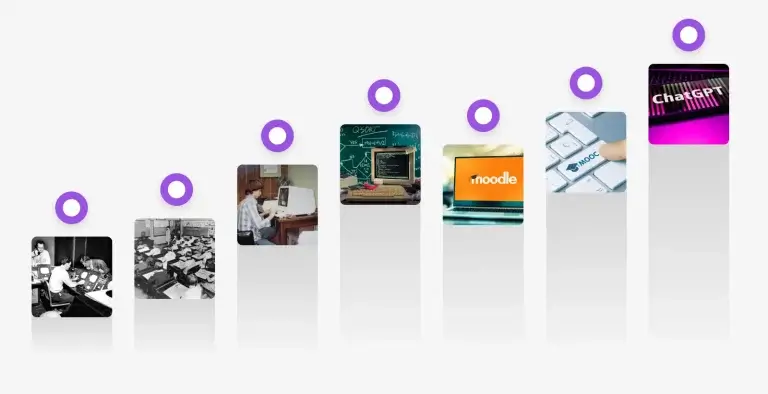Table of Contents

People have been discussing the transformative power of artificial intelligence since the 1950s when Alan Turing proposed a test for machine intelligence.
Seven decades later, Unesco predicted that AI in education will be worth $6 billion and the most recent market research suggests it can be valued at up to $20 billion by 2027. Today, this prediction feels more accurate than ever, as ChatGPT now dominates conversations worldwide.
But, what does this mean for educators, teachers, creators, and students?
LearnWorlds’ co-Founder & Chief Product Officer, George Palaigeorgiou Ph.D., joined us for a discussion on the effects of these technologies on our lives.
As a former assistant professor at the University of Western Macedonia, George Palaigeorgiou has been researching educational technologies, including AI in education for more than two decades.
The Modern History of Technology in Education (Highlights)
Every technology that disrupted the social narrative was viewed as a game-changer in education from the radio to the television and even artificial intelligence 70+ years ago.
Still, the modern classroom approach has barely evolved from its roots in the 1800s, and the pedagogic approach of the classroom has adopted some modern technologies without really changing the educational process.

Here is a short history of modern technologies in the classroom:
Exploring the Pros and Cons of Integrating A.I. in Education: Benefits, Opportunities, and Risks
The use of A.I. in education has the potential to transform the way we learn, making it more personalized, engaging, and accessible for everyone. However, we need to be mindful of its potential drawbacks, such as content overload, fake news, and lack of critical thinking skills. We’ve seen both success stories and cautionary tales about the use of A.I. in education, which underscores the importance of implementing it responsibly. This means being transparent about how algorithms are used, protecting students’ privacy, and using A.I. in a way that fosters creativity and innovation. The educational revolution that A.I. promises is an exciting prospect, but we need to be aware of its challenges and address them head-on.
George Palegeorgiou, Ph.D., LearnWorlds CPO
Artificial Intelligence has the potential to transform and democratize education, and, at the same time disrupt, impede, and confuse.
As every technology is a tool for both good and bad, A.I. should be viewed as a double-bladed sword that needs to be handled with care.
Advantages of Using A.I. in the Classroom
There are three main advantages of artificial intelligence in the classroom:
Accessible & equal education
Learning is often limited by the capabilities and availability of the teacher. A.I. tools can help make education more accessible to learners with learning disabilities or learning differences. For example, an A.I. tool can provide real-time transcription and content adaptation to assist students who are deaf or non-native speakers.
Reduction of the cognitive load
Reducing a lot of the unnecessary cognitive load of students can help them focus on what matters, get direct access to the most relevant information, and learn at a faster pace.
Personalized learning
A.I. tools can analyze data about each student’s learning style, pace, and preferences to create a personalized learning experience. Not all people learn the same way or at the same pace, so, artificial intelligence can assist the learning journey by personalizing the material to suit each student.
Unpacking the Challenges of A.I. in Education
On the other hand, we should recognize the dangers artificial intelligence comes with. There are many educational challenges to take into consideration.
These are only part of the challenges that led some of the brightest heads of our generation to co-sign the Future of Life Institute’s open letter for a pause in A.I. development.
Content Saturation
An overwhelming amount of content given by A.I. may lead to content fatigue and demotivation. Too much educational content may end up having the exact opposite effects, and decrease academic performance.
Developing lazy minds
Critical thinking is becoming increasingly important, and in an age where misinformation spreads rapidly, the danger of developing lazy minds and non-critical thinkers is a danger to society in general.
There are several potential risks and challenges associated with using A.I. in education, even as a powerful assistant. Let’s explore the most vital ones.
Bias & Misinformation in Algorithms
A.I. algorithms can be biased if they are trained on data that is not representative of the student population. This can result in inaccurate assessments, also known as hallucinations or recommendations that may disadvantage certain groups of learners.
Data Privacy and Security
A.I. relies on collecting and analyzing large amounts of data, including sensitive information. The use of A.I. in education may pose a risk to students’ privacy and personal information if not managed properly.
Lack of Human Interaction
While A.I. can provide personalized feedback and support, it cannot replace human interaction and the social and emotional learning that comes with it. Over-reliance on A.I. may result in students feeling isolated or disconnected from their peers and teachers.
Ethical and Legal Concerns
The use of A.I. in education raises ethical and legal questions around issues such as algorithmic bias, data privacy, content ownership, and transparency. Educational institutions and training providers must consider these issues when implementing A.I. tools.
Overall, while A.I. has the potential to be a powerful assistant in education, it is important to address these risks and challenges to ensure that its use is responsible, equitable, and effective for all students.
Preparing for the A.I.-powered Classroom of the Future
The rapid development of artificial intelligence (AI) technology is expected to revolutionize the education industry, transforming the classroom into an A.I.-powered learning environment. This shift will have a significant impact on the role of educators and how they approach teaching.
Let’s explore some scenarios:
Creating curriculum outlines & Prototyping content (creating drafts, outlines, etc) can be technology-assisted to draft and prepare the lesson material.
Developing educational content will not be the same anymore. Creating assignments, lecture content, handouts, and even video, will be done with A.I. to speed up the process.
Eliminate creative blocks. Do you have times when the blank page is your worst nightmare? An autocomplete function or an A.I. writing tool can help push back and continue your work.
Developing critical thinking will become the most important skill to teach across all levels of education.
Grading the assignments, a dreaded task for every educator is a pile of papers to read and evaluate objectively. This task may be partially automated or A.I.-assisted soon.
A.I. will assist in every level of the teaching process, from how to write a question in the exams to correcting the papers, and even give options on how to respond to the students.
It will take the mundane tasks away from the teacher and the time-consuming work of the students, to be replaced with more valuable in-depth knowledge.
The A.I.-powered classroom of the future will require educators to embrace new ways of teaching and learning, as well as to develop new skills and competencies. While the role of educators may change significantly, their ultimate goal of fostering student learning and growth remains the same.
Below you can see an example built by students as an implementation of ChatGPT with a robot-like face that can answer students’ questions. The story was reported by Reuters: Hello AInstein! Robot with ChatGPT shakes up Cyprus classrooms

A.I. Tools in the Service of Education
Let’s explore the various tools that educators and students may soon have access to in the classroom, perhaps sooner than anticipated.
These and many more tools including specialized applications for learning will be more common, as creating web and mobile applications becomes easier and powered by artificial intelligence.
Already, Duolingo uses GPT4 for its language learning chatbot, explaining key grammatical concepts and roleplays as different personas to practice. To achieve this, they’ve trained their chatbot on data specific to their use case.

Education Entrepreneurs: Reinventing Themselves for the Future
Educators and course creators alike will be challenged and have to re-invent their identities to stay competitive and relevant.
As more tech-savvy creator-entertainers join the educational market, creating courses with A.I.-assisted tools, the elearning market will change. Then, a big question arises:
How Can You Stay Relevant as an Educator?
As the AI revolution continues to reshape the education landscape, educators must adapt in order to remain competitive. Here are three strategies you can employ
With the emergence of AI technology, you must keep up with the latest advancements in your field to remain competitive. It’s essential to develop expertise in your area of teaching to provide your students with the best possible learning experience. This can be done by taking part in professional development opportunities, attending conferences, networking with peers, and staying up to date with research and publications. By doing so, you will be able to offer your learners valuable insights and perspectives.
Then, remember, AI technology offers new and exciting opportunities to engage learners and create a more personalized learning experience. You can explore new teaching strategies that leverage AI-powered tools to better understand and adapt to individual student needs.
Learning is a social process, we learn from each other and through interactions. While artificial intelligence can replace parts of the learning process, it cannot fully replace social interactions. By offering a community of learning and expert instructor guidance, you are positioning yourself above the masses.
AI-powered tools and platforms can help you streamline your teaching process, automate administrative tasks, and provide better insights into student performance.
For example, learning management systems can track student progress and identify areas where students need additional support. Additionally, natural language processing tools can analyze student writing and provide feedback on grammar and style, helping students to improve their writing skills.
By incorporating AI-powered tools and platforms in your teaching practice, you can improve the overall learning experience for your students, while also making your job easier and more efficient.
A Legal View of AI Content: Copyright, Ownership, and the Legal Framework
*This section is authored by Vassia Pikrou, Head of Legal Counsel at LearnWorlds.*
Today artificial intelligence is already vastly used to create and generate works in music, software, journalism, marketing, literature, etc. The produced work could be perceived as free to use because it has not been created by a human, thus not covered under the protection described below.
From a commercial perspective, this is terrible news for any company that could potentially spend vast amounts of money for the creation of a specific work of authorship by an A.I.
Traditionally the use of computers to generate literary, artistic, or any other work of authorship did not create any issue regarding the ownership of copyright as the computers were used as mere tools in the creation process.
In the same direction as the above, the position of the majority of EU jurisdictions is that only works created by a human can be protected by copyright.
There is ample room for legislators to tackle this issue of who will own the copyright to a work of authorship, if this is generated by an A.I. There have been arguments that the ownership should be bestowed to the developer that has created the specific parameters for the said creative outcome. However, this could be perceived as granting ownership rights to the creator of the tool.
Already there are rulings from EU and US courts deciding that work products by an A.I. should not be copyrighted. But there is a silver lining there. If the artist or author can prove to exert creative control over the outcome of the A.I. then this particular work should be protected and ownership should be granted.

The real issue emerges when the A.I. has created something entirely on its own without any creative control or direction. This is the field, where the legislator needs to step in and regulate in a way that does not hinder creativity and innovation.
Adapting to the A.I. Challenge for the Future of eLearning
As technology continues to advance, AI is changing the way we learn. While this brings exciting new opportunities for education, it also brings challenges. In the future, teachers will need to find the right balance between using AI and interacting with students. They should focus on their expertise, build strong learning communities, and create engaging educational experiences for students.
George Palegeorgiou, Ph.D., LearnWorlds CPO
New technologies tend to disrupt the status quo. The rise of A.I. in education has the potential to significantly transform the eLearning landscape and change how we work, learn, and search for information, along with a myriad of other social and economic processes.
In the AI-powered classroom of the future, educators will need to adapt their roles, focusing on critical thinking and learning to use the tools at their disposal. To stay relevant, educators must emphasize their expertise, foster learning communities, and provide engaging educational experiences.
As A.I. continues to develop, striking the right balance between AI and human interaction will be crucial for the future of eLearning.
You can keep track of changes in the AI technology by following the news, for example with the AI tracker or other websites serving news around artificial intelligence.
P.S.: This article was written by a human with the use of A.I. to rephrase, improve the content, or get past creative blocks. It is an example of how Artificial Intelligence can take up the role of a personal assistant to develop high-quality content.
Acknowledgments
Nick Malekos is a Senior Digital Marketer in LearnWorlds. He is a results based and well-rounded Digital Marketer with years of experience in the education industry, writer and digital literacy trainer.






